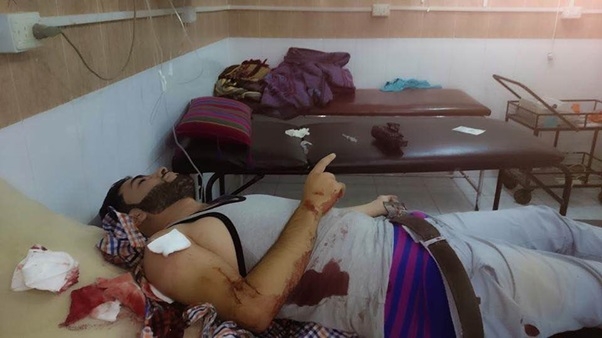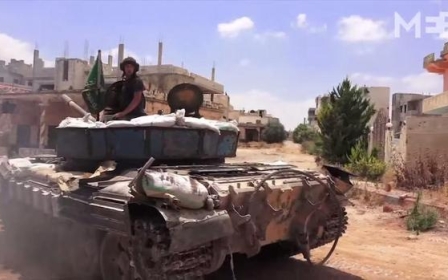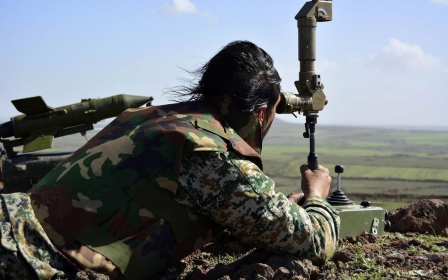The mysterious assassinations of Syria's Daraa

A wave of assassinations and attempted killings in rebel-held Daraa has raised security concerns in the province, the only opposition-controlled stretch of war-torn Syria that enjoys a degree of day-to-day stability.
In the last three months, some 35 people have been shot and killed by unknown assailants, on streets and in villages far from the frontline, locals told Middle East Eye, some of whom were targeted themselves.
On the afternoon of 2 September, Judge Bashar Khaled al-Naimi, vice president of the opposition’s Court of Dar Al Adil in Houran and a prominent opposition figure, was shot by unidentified gunmen in the eastern countryside of Daraa as he was driving home from work.
Just over a week later, on 11 September, another well-known opposition voice, 22-year-old Al Jazeera correspondent Montasser Abu Nabot, was targeted.
"It was in the morning and I was driving through the countryside west of Daraa on my way to prepare a report for Al Jazeera,” Abu Nabot told MEE. “I was surprised by masked gunmen opening fire on my car, and immediately I jumped out of the car to the ground.”
It was a close escape for the journalist. “The gunmen fired more than a dozen bullets into my car and one caught me in the right arm. After they left, I got back in the car and went to a nearby field hospital for treatment. I could not believe that I was still alive."
Scarcely a week later, on 19 September, another unidentified group of gunmen did not miss their mark: 31-year-old media activist Ahmed Masalmah was shot and killed as he walked down a street in the city of Daraa. It was just before 10pm and he was walking home from an office run by the Naba Media Organisation where he worked.
Journalist Abu Nabot has been tracking the assassination trend, but he wasn’t prepared to become part of the story. Now in Jordan recovering, he says there is little precedent for violence like this in Daraa, calling it “a strange phenomenon”.
Islamic and secular factions
The violence has unsettled activists and opposition members alike in Daraa province, which is a major stronghold of secular fighters in Syria. The largest group of opposition fighters in Daraa is the Southern Front of the Free Syrian Army (FSA) with about 35,000 men. There are other, smaller FSA groups, and Islamic factions, mainly al-Nusra Front, Muthanna and Ahrar al-Sham.
In Daraa, infighting between opposition factions, along the lines of what has happened in eastern and northern Syria, has been rare. But the spate of shootings comes at a crucial time for both Daraa’s secular and religious fighters.
After making significant gains in the first half of this year, the mainly secular Free Syrian Army, in particular the Southern Front, controls 65 percent of Daraa province. The Southern Front receives vital weapons, ammunition, expertise and financial backing from the Military Operations Centre (MOC) in Jordan, which is staffed by senior military and security figures from 14 nations, including Jordan, the US, Qatar, Saudi Arabia and several European countries. It has been backing the FSA’s vision for a democratic, secular Syria and supporting the groups that share that vision.
This has caused friction with others who don’t share the vision. Over the first six months of this year, as the secular fighters made gain after gain and increasingly excluded religious Muslim groups from taking part in MOC-backed operations, many found themselves on the outs.
On 25 June, around the same time the assassinations began, the FSA began its much-hyped, MOC-backed Southern Storm operation to oust government forces from the city of Daraa. Had it succeeded, the possibility of an FSA-controlled, democratic and secular Daraa would become more likely.
Instead, the operation stumbled frequently and failed in early September with a loss of nearly 200 Southern Front fighters and hundreds of civilian casualties, mainly as a result of intensive bombing by Assad’s forces. Since then, the Southern Front has been unable to execute any battles or operations in Daraa against government forces who have managed to repel all rebel attempts to capture the city.
“The battle for the city of Daraa has stopped and the military situation now is the same as it was before the battle,” said Bashar Zoabi, commander of the Yarmouk army. “Both us and the regime each control our own areas.”
A friend of Ahmad Masalmah took to Facebook to speak out after the activist’s death. He said Masalmah had previously fought off attempts on his life by al-Nusra Front, and had confessed to being afraid that al-Nusra might try to kidnap or kill him again.
Senior commanders have thus far avoided pointing fingers close to home. Zoabi, whose Yarmouk Army is one of the largest military formations in the Southern Front, told MEE, “It could be the regime or it could be Islamic State (IS) sleeper cells carrying out these assassinations. We have strengthened barriers and security measures. There are no factions in Daraa that want to destabilise the security situation in Daraa.”
Outsiders watched
If it is outsiders carrying out the assassinations, they are hiding amongst locals. Despite a transient population with displaced people frequently shifting villages and moving closer to the city from more heavily bombed rural areas, outsiders stand out in Daraa. It wouldn’t be easy for a person from another part of Syria to move around opposition-held Daraa without locals taking note.
At least one of the killings in Daraa has been claimed by IS. Ahmed Mohammed al-Falluji, a security official for al-Nusra Front in Daraa was shot and killed as he drove his car on the night of 17 August.
IS’s Willayat Dimashq media office claimed responsibility for his death in a statement on its official website. The statement claimed one of its security detachments had “assassinated a security official ... in Daraa Al Balad, all praise and gratitude be to Allah”.
But the vast majority of the killings are unclaimed and assailants unknown.
People in Daraa are largely cautious about discussing IS. Civilians and opposition military personnel say they fear IS will make further inroads into their homeland, beyond the presence it has already established in northeast Daraa, in the rural area near Housh Hammad.
Opposition factions have thus far fought back and the IS offensive hasn’t spread, but the fear of sleeper cells operating closer to Daraa’s more populated rebel heartland is pervasive. Any activation of sleeper cells closer to Daraa city would pose a significant threat for the province’s stability and security.
Daraa remains a target for both the Syrian government and IS. Opposition fighters find themselves on two separate fronts, first battling the government and working towards its expulsion from the province, and second fighting IS and preventing it from reaching further into Daraa.
Despite being hampered by a two-fronted battle, the Southern Front won’t compromise on its long-term goal, said Zoabi.
“We face a difficult future while a criminal like Assad continues to bomb civilians and with the overt and increasing Russian presence in the region. But we will fight this regime until we have our freedom, and will not submit to any truce with the regime,” he said.
New MEE newsletter: Jerusalem Dispatch
Sign up to get the latest insights and analysis on Israel-Palestine, alongside Turkey Unpacked and other MEE newsletters
Middle East Eye delivers independent and unrivalled coverage and analysis of the Middle East, North Africa and beyond. To learn more about republishing this content and the associated fees, please fill out this form. More about MEE can be found here.




